Dec 30, 2025
Dec 30, 2025
Pilgrimage-II
In the previous part, the objectives and importance of pilgrimage in Hinduism was explained briefly enumerating popular Pilgrimage Events/Sites in India. These included Kumbha melas, Char Dham yatras, Kanwar pilgrimage, holy cities, major temple cities, Shakti Pithas, Jyotirlingams, and so on.
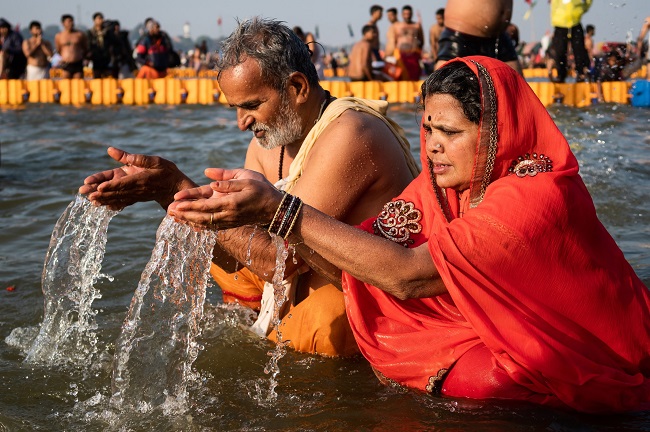
Many of these sites are remembered for the incarnation of divinities, motivational events, and various other events associated with the divine and great human beings. As already mentioned earlier, such places and sites have been so often memorialized or immortalized as shrines or temples and community people are encouraged to visit them for own material and spiritual good and well being. While all such events and places were briefly explained by this author in the previous piece; however, it is felt that some of them needed more description with the greater details. It was in that context that the Char Dham pilgrimage places was undertaken for elaborate description in the previous part and, in continuation of the same spirit and quest, the Kumbha melas and a few more significant temples and shrines are proposed to be discussed at a greater length in the present part.
Kumbha Mela
According to some accounts, the Prayag as a holy bathing pilgrimage finds mention even in the oldest Hindu Holy Scripture Rig Veda and some ancient Buddhist texts. In the world’s greatest Epic Mahabharata too, Prayag is referred to as a bathing pilgrimage for Prayaschitta (i.e. penance or atonement) of sins and mistakes incurred in the past. It finds a mention at a place just before the Epic War as "the one who observes firm vows, having bathed at Prayag during Magha, O best of the Bharatas, becomes spotless and reaches heaven.” Similarly, in the Anushasana Parva following the great war this bathing pilgrimage finds a mention as a sort of ‘Geographical Tirtha’ which must be united with ‘Manasa Tirtha’, so as to make sure that every human being dutifully exercises certain universal values such as Satya (truth), Sanyama (self-control), patience, and so on for self-realization.
Kumbha Mala comprises of two Sanskrit words: Of this, Kumbha means a “pitcher or pot” which finds a mention in many ancient Vedic texts, usually in the context of holding water as also in some mythical legends about the nectar of immortality. For instance, Kumbha and its derivative words are mentioned in the Rig Veda (Verse 10.89.7) and in many verses of the remaining three Vedas i.e. Yajur Veda, Sama Veda and Atharva Veda, as also in several other Vedic and post-Vedic texts of the ancient Sanskrit literature. In Hindu astrological texts too, Kumbha finds a reference as the zodiac sign of Aquarius. On the other hand, the word Mela carries the meaning of “join, assembly, meet, etc.” in the context of community celebration or fair. This word too finds a mention in the Rig Veda and several other ancient Hindu texts and, in essence, the two words together imply assembly (of people) around the water or the nectar of immortality in mythical context. In the later age and medieval period texts too, Prayag and Kumbha Mela finds references at many places. For instance, the 7th century Chinese traveler Hiuen Tsang describes Prayag as a holy Hindu city with numerous temples and bathing rituals at the junction of rivers. Many Hindu Puranas too refer to the Prayag Mahatmya, with Matsya Purana specifically having detailed description of Prayag rivers and its importance to Hindu pilgrimage.
Apparently, the Kumbha Mela of Haridwar too has been considered a very pious and significant event since ancient age, which is also regularly held for long according to the astrological symbol of Kumbha (Aquarius) in a twelve-year cycle. Even Mughal era historical texts namely Khulasat-ut-Tawarikh (i.e. Epitome of History, Persian) written by Sujan Rai and Chahar Gulshan (i.e. Four Gardens, Persian) by Rai Chatar Man Kayath contain the reference of Kumbha Mela describing the Haridwar bathing fair every twelfth year, and also mentions about the bathing festivals at Prayag and Nashik. Like the Prayag and Haridwar Kumbh Melas, similar bathing pilgrimage melas at Nashik (Maharashtra) and Ujjain (Madhya Pradesh) too find references in earlier texts but as the Simhasth or Singhasth Mela symbolizing Jupitar in Leo in astrological terms. The usage of terms like the “Maha Kumbh” and “Ardh Kumbha” to describe these bathing pilgrimages at Prayag, Nashik and Ujjain appear to be more of the modern age development.
One of the key features of Kumbh Melas at the aforesaid places is huge assemblage of Hindu Sadhus (monks) in various Akharas (multiple camps and processions) belonging to different traditions such as Shaivism, Vaishnavism, Udasis, Nirmalas, and so on belonging to both Hinduism and Sikhism. These periodical bathing festivals have traditionally attracted huge attendance of religious Hindus for centuries. In addition to their religious significance, the Kumbh Melas also occur as major economic and commercial events, for initiation and recruitment to Akharas, community prayer and recital, spiritual discourses and debates, and so on. During the colonial era, the East India Company saw an opportunity in these fairs and even resorted to collection of a pilgrim tax that became a major source of revenue collection for them, which was, however, resisted by the devotees and later abolished by Lord Auckland in 1938 after several protests.
According to an ancient mythical legend, when the churning of the Ocean of Milk was undertaken by the Devas and Asuras, the Amrit (heavenly nectar of immortality) emerged in the last. Now a fierce fighting emerged between the two sides for thy possession of Amrit but Vishnu took the form of Mohini and cleverly took the possession of the Amrit Kalash. While the Amrit Kalash was being taken away from Asuras, a few drops of the divine nectar fell at four different places on the earth, namely Haridwar, Prayag, Trimbak-Nashik and Ujjain. Consequently, these places acquired mystical power and spiritual significance whereby a person bathing at these places during the Kumbh Mela becomes entitled to Moksha (liberation). In the modern age, the Kumbha Melas are described and categorized as under:
(a) The Purna Kumbh Mela or full Kumbh Mela, which occurs every twelfth years at the aforesaid sites;
(b) The Ardh Kumbh Mela or half Kumbh that occurs every six years between the two Purna Kumbh Melas at Prayag and Haridwar;
(c) The Maha Kumbh Mela, which occurs every twelve Purna Kumbh Melas i.e. after every 144 years.
In addition, holy bathing festivals are organized at these sites every year too at the earmarked time and dates. More recently, on the occasion of Purna Kumbh in 2019 at Prayag, it was resolved in a congregation that henceforth the Ardh Kumbh Mela would simply be referred to as the Kumbh Mela and Purna Kumbh Mela shall be known as the Maha Kumbh Mela. The main highlights of various Kumbh Melas are briefly explained in the following paragraphs.
1. Prayag Kumbh
This Kumbha Mela is organized at the Sangam (junction) of Ganga and Yamuna rivers (as also invisible Saraswati) at Prayag, a holy city. During the months of January-February and of the three most auspicious dates, the first bathing event falls on Makar Sankranti, the second on Magh Amavasya and the third on Vasant Panchami of the Hindu calendar. Astronomically, Jupiter remains in Aries, Sun and Moon in Capricorn or, alternatively, Jupiter in Taurus and Sun in Capricorn during this period. The holy bathing site is popularly known as Triveni Sangam that represents confluence of three ancient rivers, of which River Ganga and River Yamuna physically exist while River Saraswati is invisible and possibly only a mythical or legendary entity. The essence of the holy site is the ritual dip in the Sangam waters by the devotees but the festive occasion that continues for days is also marked as the community commerce event with fairs, musical and entertainment programmes, educational and religious discourse by the saints and scholars, and mass feeding of monks and poor people.
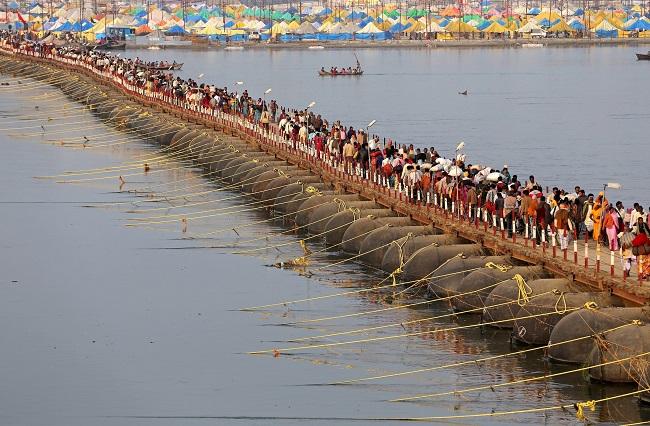
As mentioned earlier, the full Kumbh Mela at Prayag is organized every twelve years and an Ardh Kumbh is held after every six years at the same venue. Besides, an annual Magh Mela is regularly held at the Prayag Triveni Sangam every year. According to a popular belief, Adi Shankara was the key inspirational source for starting the Kumbh Mela at Prayag and congregation of Akharas at the Sangam site in the eighth century CE. Among many historical texts recording the periodical occurrence of religious mass gathering and bathing ritual at the Triveni Sangam, the Prayag Mahatmya section of the Matsya Purana and Ramcharit Manas of poet and saint Tulsidas are among the prominent ones. In December 2017, The UNESCO declared the Kumbh Mela to be an intangible cultural heritage of humanity in December 2017. The last full Kumbh Mela was organized in the year 2013 which is considered to be the largest ever religious gathering with approximately 120 million people visiting Prayag over a two-month period; the last Ardh Kumbh was held in 2019 and the next Purna (full) Kumbh is scheduled for 2025. The exact period and date is reckoned on the basis of Hindu luni-solar calendar.
2. Haridwar Kumbh
Haridwar Kumbh Mela is organized at the banks of River Ganga which falls during the months of January – April with first bathing event falling on Shivaratri, the second on Chaitra Amavasya (new moon) and the third on the Mesh Sankranti. Astronomically, the planet Jupitar enters in zodiac Aquarius and Sun into Aries around this time. This Mela is held every twelve years at Haridwar, Uttarakhand state and the exact dates are determined according to Hindu astrology. The event carries a deep spiritual and religious importance to Hindus and the spiritual seekers of the other Indian religions as well. According to certain historical accounts, the bathing fair at Haridwar is the original Kumbh Mela having recurrent twelve years cycle while similar melas at three other sites are actually adaptation of Haridwar’s Kumbh Mela. For centuries, this Mela has been considered as an important commercial event as well wherein merchants from as far as Arabia participated in the past.
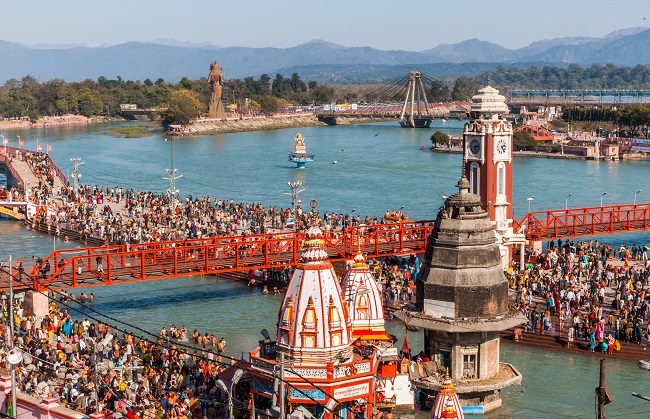
In its almost 400 years of well documented history, the Kumbh Mela at Haridwar carries many eventful records of glorious and infamous occurrences as well including violent clashes of the Akharas of the Shaivite and Vaishnavite traditions, and serious epidemic outbreaks. According to a British account following 1857 mutiny, the visitors at the Haridwar Mela included a large number of merchants, elephant dealers, horse traders from the Middle East, grain and confectionery merchants, cloth merchants and toy sellers besides the usual large number of pilgrims including priests, soldiers, religious mendicants and common people. Several Hindu kings, Muslim Nawabs and Sikh royals too used to attend this fair. The last Kumbh Mela was organized from 1st to 30 April 2021 amidst the Covid-19 pandemic. Fearing that the event may prove to be a super-spreader of the dreadful disease, the Prime Minister of India himself had made appeal to the heads of major Akharas to keep it only symbolic. Following his appeal, the heads of major Akharas favourably responded by announcement of withdrawal and closure of the event preponing it by several weeks to save precious lives.
3. Nashik Kumbh
Nashik Kumbh Mela or Nashik-Trimbakeshwar Simhastha is organized at the banks of River Godavari which falls during the months of August-September with first bathing event falling on Simha Sankranti, the second on Bhadrapada Amavasya and the third on theDevotthayan Ekadashi. Astronomically, the planet Jupitar enters into zodiac Leo and/or Jupiter, Sun and Moon enter into Cancer on lunar conjunction around this time. This Hindu religious fair too is organized every twelve years in the Nashik district of the state of Maharashtra and it involves ritual dip in waters at the banks of the River Godavari at the Trimbakeshwar Shiva Temple (in Trimbak) as well as the Ram Kund there. Earlier, this fair was held at the Trimbak only for a long time up to 1789 CE; however, after a serious dispute and clash between the Shaivites and Vaishnavites over the order of precedence of the bathing right, the then Maratha Peshwa segregated two traditions and the Nashik city was marked for the Vaishnavites.
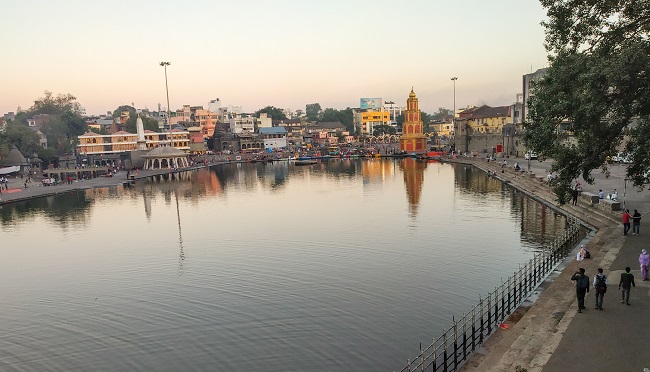
While Prayag and Haridwar Kumbh appear to have a very long history, the Nashik Simhastha and the one at Ujjain appear to be later developments. The former appear to have derived the nomenclature of Kumbh from the Haridwar Kumbh Mela while the latter was probably an adaptation of the Nashik one. Trimbak was a small town near the Nashik city and the fair was originally held there only. However, the clash between the Shaivite sanyasis and Vaishnavite bairagis in 1789 reportedly led to the death of a large number of ascetics, therefore, the then Peshwa gave a ruling for the Shaivites to continue at Trimbak while the Vaishnavites were shifted to Ramkund in the Nashik city as separate bathing sites. The last Kumbh Mela at Nashik was organized in the year 2015 which was visited by approximately 30 million people for the holy dip in the Godavari waters and the next Kumbh at Nashik is scheduled in the year 2027.
4. Ujjain Kumbh
Ujjain Kumbh Mela is organized at the banks of River Shipra which falls during the months of April-May with first bathing event falling on Chaitra Purnima, the second on Chaitra Amavasya and the third on the Vaisakh Purnima. Astronomically, the planet Jupitar enters into zodiac Leo and Sun in Aries around this time. Like all the earlier stated Kumbhs, the Ujjain Simhastha is a religious Hindu Mela with a periodicity of twelve years celebrated in Ujjain city of the state of Madhya Pradesh. From the available historical accounts, the Ujjain Kumbh appears to be an adaptation of the Nashik-Trimbak Simhastha that started in the current form in the 18th century CE at the initiative of the Maratha Peshwa Ranoji Shinde. Ever since, the two Kumbh Melas at Nashik and Ujjain are usually carried out within one year of each other and the latter carries special tribute and reverence to the Mahakaleshwar Jyotirlinga Temple, one of the twelve important abodes of god Shiva’s Swayambhu lingam. Occurrence wise, the Nashik Mela is celebrated first if Jupiter enters zodiac Leo between spring and late summer but the Ujjain Mela precedes it if Jupiter enters Leo before spring.
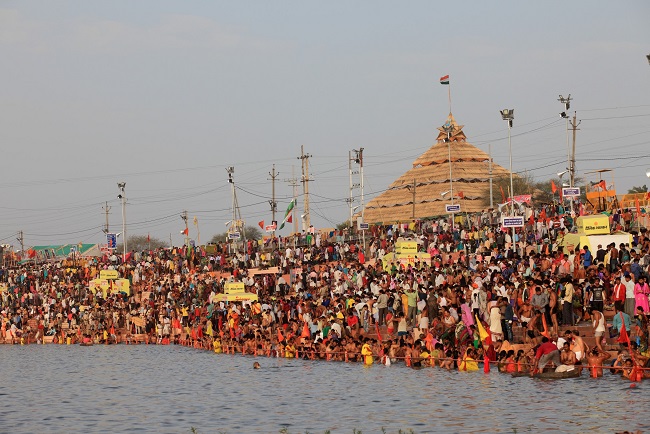
This riverside fair is celebrated at the banks of River Shipra attracting millions of pilgrims at each occasion. In the book Khulasat-ut-Tawarikh, the city of Ujjain finds a mention as a very sacred place in the Malwa region. Like in the Nashik Kumbh, the bathing places of the Shaivite and Vaishnavite ascetics in Ujjain too have been separately earmarked for centuries now owing to their earlier clash and under this arrangement, the sanyasis would bathe on one side of the river while the bairagis on the other side. During the British period, the Ujjain Kumbh Mela was part of the princely state of Gwalior ruled by Scindia dynasty, which used to traditionally bear about half of the Kumbh expenses. Notwithstanding such arrangement, occasional conflicts and clashes continued during the British rule. Therefore, the British rulers decided to disarm the sadhus of different Akharas and effectively enforced it after 1850 CE. The last Ujjain Kumbh Mela was organized from 22nd April to 21st May in 2016 wherein nearly 75 million people are believed to have participated.
Important Hindu Temples and Shrines
The country boasts of several holy cities and numerous religious monumental sites across its vast length and breadth. These temples and shrines belong to various sects and traditions of Hindus, the majority of which belong to the two most prominent and key traditions, namely Shaivites and Vaishnavites dedicated to trimurti gods either Shiva or Vishnu respectively with their various attributes and nomenclatures. While, the actual number of such important temples and shrines in the country is quite large but only a few more significant ones attracting mass pilgrims are described here.
1. Kedarnath Temple
The Kedarnath Temple is located in the Garhwal Himalayan range on the shores of the River Mandakini in the state of Uttarakhand. This ancient temple is dedicated to Shiva, at least over a millennium old and open to pilgrims only from Akshaya Tritiya (April) to Kartik Purnima (November) every year owing to extreme weather conditions. During the remaining period, the deity is shifted to Ukhimath for worship during the months of harsh weather conditions. From plains, the temple is accessible by road up to Gaurikund and from there pony, mule and manchan services are usually engaged by the pilgrims to carry on with uphill trek of about twenty-two kilometers reaching the temple. This site is also part of India’s Chota Char Dham pilgrimage and the highest among the twelve Jyotirlingas. The presiding deity (Lingam) has a pedestal about 3.6 metre in circumference and same measure in height. Besides, four more temples, namely Tungnath, Rudranath, Madhyamaheshwar and Kalpeshwar also exist around Kedarnath which together constitute the Panch Kedar pilgrimage.
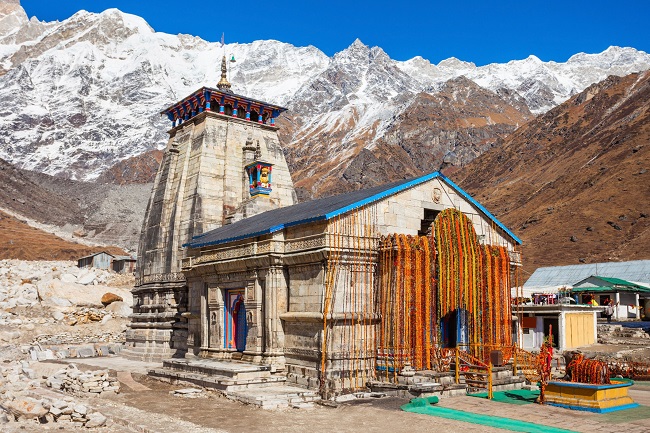
The meaning of Kedarnath is the lord of field (kedarkhand) having been derived from Sanskrit Kedara (i.e. field) and Natha (i.e. lord). According to a legend, the temple was initially built by the Pandavas brothers of Mahabharata fame. After the Great War, the guilt ridden Pandavas desired for atonement the sin of fratricide and Brahmanahatya. So they handed over the reins of kingdom to King Parikshit and looked for Shiva’s blessings in Kashi. However, Shiva avoided them for their sins, so they went to the Garhwal Himalayas in his hot pursuit. Ultimately, Shiva appeared before them at five different places, where the brothers built five temples for venerating and worshipping him. One hall inside the Kedarnath Temple carries statues of the five Pandavas brothers, Shree Krishna, Nandi (vehicle) and Virabhadra (guard of Shiva) while statues of Draupadi and some other deities are kept in the main hall itself. Kedarnath was very badly affected during flash floods in 2013 causing extensive damage in surroundings but not much to the main temple.
2. Somnath Temple
The Somnath Temple is located in Prabhas Patan, Veraval in the state of Gujarat which is considered as one of the most popular and holiest pilgrimage sites for Hindus. It is also known as Deo Patan and believed to be the first among the twelve Jyotirlinga shrines of Shiva. This is one temple to have witnessed the maximum repeated destruction and atrocities from the Islamic invaders and rulers, starting from the most infamous raid, loot and destruction by Mahmud of Ghazni in the eleventh century CE, documented by his own court historian Al Biruni, and it was reconstructed many times. The last reconstruction and renovation was done after the independence from the colonial rulers at the initiative of country’s first Home Minister Sardar Vallabhbhai Patel when its ruins were demolished, and mosque at the site shifted elsewhere; the temple as it exists in the present form was reconstructed and completed in the Maru-Gurjara style of Hindu architecture in 1951 and opened by the first President Rajendra Prasad. The temple is located along the coastline of Prabhas Patan near Veraval in Saurashtra region of Gujarat and the name ‘Somnath’ implies the “Lord of Soma (moon)”.
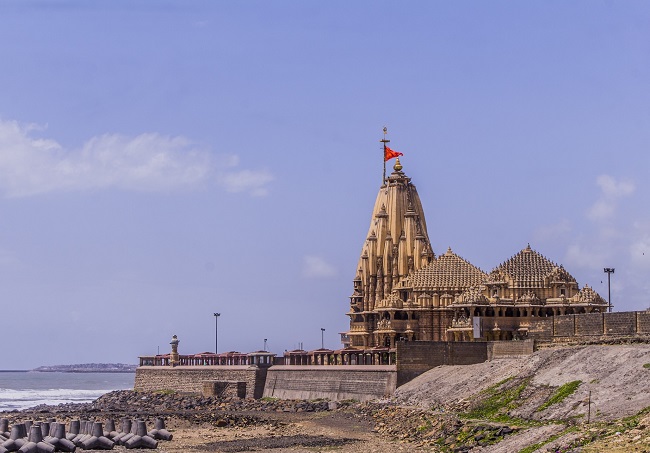
Somnath Temple now houses one of the most auspicious Jyotirlinga and is a holy place of pilgrimage for Hindus as also one of five most revered sites on the seacoast of India, others being ones at nearby Dvaraka in Gujarat, Puri in Odisha, and Rameshvaram and Chidambaram in Tamil Nadu. In many Sanskrit texts such as Vana Parva of Epic Mahabharata and Bhagavata Purana, the locale of this temple i.e. the Prabhas Patan (Pattana), finds mention as a Tirtha (pilgrimage site). The present Somnath Temple is an intricately carved, two level temple with pillared Mandapa and 212 relief panels. The temple’s main spire (Sikhar) is about fifteen metres in height above the sanctum with over eight metre tall flag pole at the top. The Somnath site has traditionally been an auspicious pilgrimage site from the ancient age being a Triveni Sangam of rivers Kapila, Hiran and Saraswati. According to a mythical tale, Soma (the moon god) had lost his luster and shine owing to a curse and after taking bath in the River Saraswati, he regained it. Apparently, the names Someshwar or Somnath (the lord of moon) are based on this legend.
3. Mahakaleshwar Temple
The Mahakaleshwar Jyotirlinga is yet another Hindu temple and pilgrimage site which is dedicated to Shiva and as one of the twelve Jyotirlingas it is among the most venerated and worshipped religious places. The temple is located in the vicinity of the holy River Shipra in the ancient city of Ujjain in the state of Madhya Pradesh. The presiding deity Mahakaleshwar is known to be dakshinamukhi, which implies that the idol is facing the south, a unique characteristic carried by the tantric Shivnetra tradition. The idoles of Parvati, Ganesha and Kartikeya are located in north, west and east of the sanctum sanctorum, and Nandi in the south. The temple is situated in a huge courtyard surrounded by walls with the lake in vicinity; five levels of the temple includes an underground structure too, the shikhar (spire) has sculptural finery and well lightened beautiful brass lamps lead way to the underground sanctum.
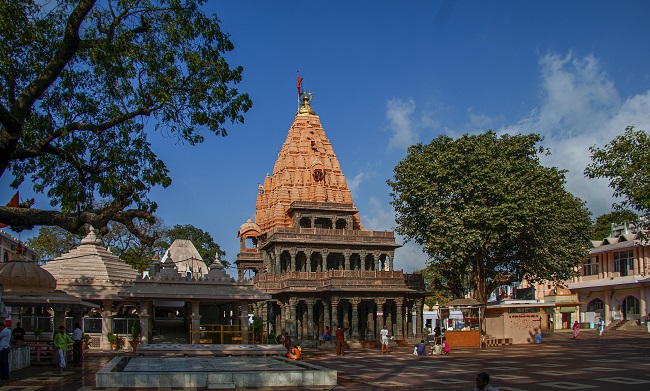
Like many other prominent Hindu temples, particularly in the northern India, the Mahakaleshwar temple too was destroyed by Delhi Sultanate ruler Iltutmish during his invasion in 1234-35 and the present structure was built by Maratha Ranoji Shinde in 1734 CE. Shiva is more popularly known as the Mahakaal in Ujjain and elsewhere, who presents an awesome spectacle with a new shringar for the famous bhasm aarti every day. On the occasion of Maha Shivaratri, a grand fair is organized near the temple with a nightlong worship followed by the procession of Mahakaal in his Palanquin (Shahi Sawari) to the River Shipra. According to a Puranic legend, King Chandrasena was an ancient ruler of Ujjain and a pious devotee of Shiva. On one occasion, two rival kings of the neighbouring kingdoms attacked Ujjain, and tried to destroy and plunder it with the support of a powerful demon Dushan. Then Shiva appeared in the form of Mahakaal and destroyed the enemies of Chandrasena to save the devotee king and Ujjain city. On the call of the devotees, Shiva also agreed to stay in the city and preside as the chief deity of the kingdom.
4. Brihadishwara Temple
The Brihadishwara Temple, built on a Chola architecture, is situated on the south bank of the River Cauveri in Thanjavur, Tamil Nadu and is officially known as Rajarajeshwaram (Lord of Rajaraja) as also Thanjai Periya Kovil and Peruvudaiyar Kovil in the local jargon. This was built by the Chola King Rajaraja during 1,003 to 1,010 and is now officially recognized as the UNESCO world heritage site. Brihadishwara is a composite Sanskrit term, of which Brihat means big or great and Ishvara means Supreme Being (God, Shiva).
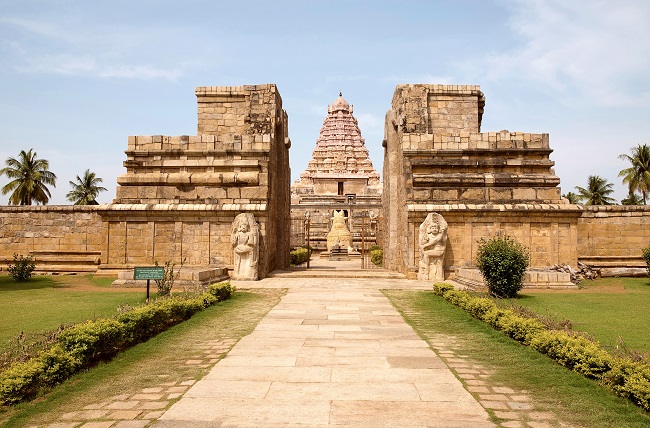
The temple complex has a large pillared and covered veranda with a spacious courtyard having about 450 metres perimeter for circumambulation. The main temple structure covers about 240 metres east to west and 122 metres north to south having five sections; the sanctum (Antrala) with a towering superstructure (sri vimana), the Nandi mandapam, mukhamandapam, mahamandapam (great hall) and the pavilion connecting the sanctum and great hall. The vimana tower above the shrine is made of granite and is one of the tallest such structures in India. The temple complex also carries shrines of Parvati, Nandi, Vinayagar (Ganesha), Murugan (Kartikeya) and many other deities, and is among the most visited sites for the tourists and devotees in South India.
5. Venkateshwara Temple
Sri Venkateshwara Swami Temple is located at the hilly town Tirumala at Tirupati (Tirupati district) in the state of Andhra Pradesh. This temple is dedicated to Lord Venkateshwara (Vishnu), who is believed to have appeared to rescue the mankind from the troubles and trials of Kali Yuga. The other common names of the temple are Tirupati Temple, Tirumala Temple and Tirupati Balaji Temple; similarly, the deity Venkateswara is also remembered with many names like Balaji, Govinda and Srinivasa. The Tirumala Hills are of low height range comprising of seven peaks corresponding to seven heads of Adi Shesha and the temple lies at the seventh peak, the Venkatadri on the southern bank of a holy water tank called Sri Swami Pushkarini. It is considered as one of the richest temples in the world in terms of its assets – wealth and obtaining donations as also the number of pilgrims and other visitors.
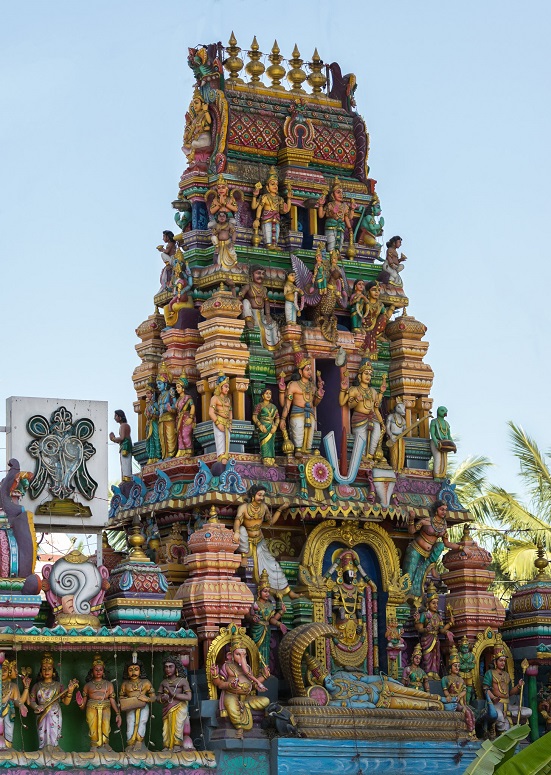
The temple represents typical South Indian architecture and was constructed over a period of time sometime during the first millennium. The Garbhagriha (Sanctum Sanctorum) is known as Ananda Nilayam where the presiding deity Venkateshwara is installed in a standing posture facing east. The temple is listed as one of the eight Vishnu Swayambhu Kshetras and employs modern management system to manage the crowd of devotees and visitors. Several ancient legends are associated with the place to glorify the deity’s association as well as piousness of the place. According to one such Puranic legend, after killing the demon Hiranyaksha, Adivaraha resided on this hill; hence Tirumala is considered as Adivaraha Kshetra. According to another legend, Adi Shesha stayed on earth at Seshachalam Hills after losing a contest with Vayu during the Dvapara Yuga and Venkateshwara would continue here throughout the current Kali Yuga owing to an earlier commitment. A charitable trust Tirumala Tirupati Devasthanams (TTD) appointed by the Government of Andhra Pradesh oversees and manages the operations of Tirumala Venkateswara Temple, including daily visitors and massive income of the temple.
6. Padmanabhaswamy Temple
The Sri Padmanabhaswamy Temple is an important Hindu temple in the state capital Thiruvananthapuram of the state of Kerala, the name of city in Malayalam and Tamil carries the meaning as “the city of Lord Ananata i.e. infinite Shesh Naag”. The principal deity of the temple is Padmanabhaswamy (i.e. Vishnu) enshrined in the ‘Anantha Shayana’ posture on the infinite and eternal serpent Adi Shesha. In the Garbhagriha, Swamy Padmanabha is seen reclining on Adi Shesha, who has five hoods facing inwards symbolizing deep contemplation. The deity’s right hand is placed on a Shiva Lingam and Sridevi (Lakshmi), the goddess of prosperity, and Bhudevi, the goddess of earth are on two sides as consorts with Brahma on a lotus emanating from the naval of Vishnu. The temple complex has two other important shrines of Narasimha (an incarnation of Vishnu) and Krishna Swami.
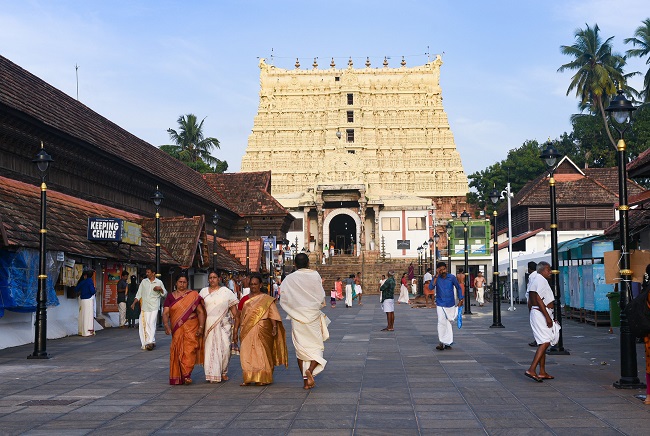
The existing gopuram of the temple is of 16th century vintage which is about 100 feet high in 7-tiers built in the Pandyan style. The temple is located near a tank called Padma Theertham (meaning ‘lotus spring’) and has a long corridor with sculptured granite-stone pillars and beautiful carvings extending up to sanctum sanctorum. The temple architecture typically presents an intricate fusion of the Chera and Dravidian styles with high walls and a 16th century gopuram. The ancient temple finds mention in several Puranas of Vaishnavite genre such as the Bhagavata Purana, Vishnu Purana, Matsya Purana, Skanda Purana, Padma Purana, etc. as also at many places in the Sangam period Tamil literature. According to a legend in Brahmanda Purana, Parasurama had purified and venerated the idol of Sri Padmanabhaswamy in Dvapara Yuga and entrusted the management of temple (Kshetra Karyam) to seven Potti families in the region. The Travancore royal family has also been traditionally linked with the temple.
7. Temples of Northern India
During almost six hundred years of Islamic rule in the large parts of the Indian sub-continent, the Northern India had to face the maximum brunt and atrocity by the Muslim invaders and rulers in as much as tens of thousands of small and big Hindu temples and shrines as well as education and literary centres were looted, damaged and destroyed. Many of these temples and shrines not only served the cultural and religious needs of Indians but also were masterpiece and classic examples of Indian architectural and sculptural finesse and arts. Many ruins of these sites still vouch for the gory and demoniac acts of the marauders of the past centuries. For instance, The Martand Sun Temple constructed by Emperor Lalitaditya Muktapida in eighth century near the city of Anantnag in the Kashmir Valley was destroyed by Sukandar Shah Miri. Yet another remarkable Sun Temple at Konark, Odisha, constructed by King Narasimhadeva, was destroyed by Muslim governor Sultan Sulaiman Karrani (Kalapahad) of Bengal, and even its ruins continue to remain as a major Hindu pilgrimage site in the modern age.
Although the majority Hindus have largely forgotten and pardoned the past excesses of the Islamic invaders and rulers, they have not been able to reconcile with these excesses at three holy sites till date, namely the Kashi Vishwanath Temple at Varanasi, Ram Janmbhumi Temple at Ayodhya and Krishna Janmbhumi Temple at Mathura, all the three desecrated, damaged and occupied sites are located in the state of Uttar Pradesh. The temple at Varanasi is an important site of one of the twelve Jyotirlingas of Shiva and an important pilgrimage centre as well while Ayodhya and Mathura temples represent the most sought after pilgrimage sites and the birth places of legendary ancient great kings Sri Ramchandra and Shree Krishna, both of whom are now venerated and worshipped by Hindus. After a prolonged legal battle, the Supreme Court of India restored the Ram Janmbhumi site to Hindus in a unanimous verdict in November 2019 and now a grand temple complex is under construction at thus acquired land. However, the legal cases in regard to the Kashi Vishwanath Temple at Varanasi and Krishna Janmbhumi at Mathura are pending in various Indian courts.
Endnote
The Hindu civilization is not only the oldest surviving culture and religion of the world but also the richest one in continued sustenance of its ancient traditions, literature, arts and such other pursuits. The ancient temples and shrines as well as many continued rituals and traditions only further vouch and strengthen these beliefs and live experiences. No other world civilization can boast of so much cultural and religious growth and diversity and consequent monumental opportunities of pilgrimage and tourism. In that context and in spite of immense damage and harm inflicted by the marauders in the past, India as a geographical entity and Hindus as an ancient civilization still continue to be blessed as people with hundreds of places and sites so memorialized or immortalized as temples, shrines and/or traditions that offer them enough opportunities for the pilgrimage and recreational or tourist ventures in an intelligent and hot pursuit of the material, moral and spiritual fulfillment in life.
Continued to Part LXXVII
Images (c) istock.com
11-Dec-2022
More by : Dr. Jaipal Singh